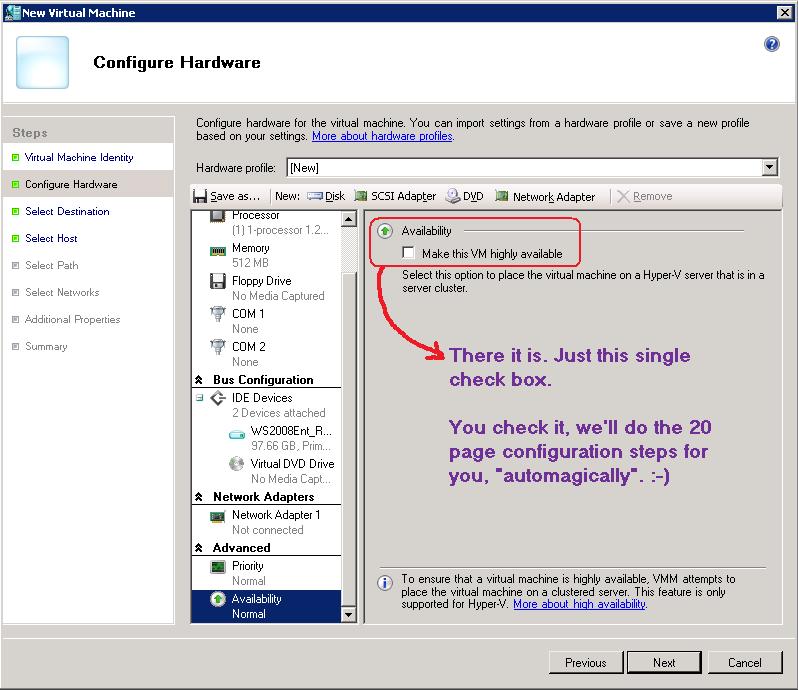Clustered Hosts and HA VMs in SCVMM 2008
Why Clustering?
When IT organizations start moving their physical computing environment to a virtualized one to consolidate their servers (increase resource utilization), increase agility and adaptability of their workloads, reduce carbon footprint, or save on floor/rack space, one thing will quickly become obvious to IT admins / architects or the IT managers:
When a physical machine is hosting multiple VMs, the physical machine itself becomes the single-point-of-failure.
This also brings in the quote from Thomas Bittman, Garner Analyst, “Virtualization without good management is more dangerous than not using virtualization in the first place.”. In the all physical world, if you lose one computer, you may only lose one workload. Now, a hardware failure on a physical host can bring down multiple workloads running inside of the VMs hosted on the physical server.
Hence, how to manage highly available (HA) hosts and HA VMs naturally become one of the most important considerations in almost all customers' virtualization project plans.
What and How Can VMM Help?
Luckily, SCVMM 2008 provides a seamless experience for creating and managing HA VMs. Here are some of the highlights on what we delivered that will make your HA VM management across virtualization platforms an easy and effective one:
- SCVMM 2008 is Windows 2008 Cluster "aware".
- When you add a host that belongs to a windows cluster, we'll automatically bring in the rest of the nodes in the cluster.
- Many SCVMM cmdlets have cluster specific parameters or switch, so that you can define how SCVMM should take actions according to the HA attribute of the target VM/host.
- When the HA VM moves, we keep track of the VM and their hosting physical cluster node.
- SCVMM 2008 supports both Windows cluster quick migration as well as the VMotion from VMware.
- When you decide to move a HA VM, the intelligent placement takes HA hosts into consideration and will recommend clustered hosts by default.
- SCVMM 2008 provides simple, actually, VERY SIMPLE, single-checkbox process to create a HA VM.
- If you have tried the white paper for configuring a HA VM on Windows 2003 cluster, you know the 37 page long manual steps you have to go through to make it work.
- Now in SCVMM 2008, all you need to do is to check a single checkbox, if you need a HA VM. We take care of all the configurations under the hood for you.
- SCVMM 2008 offers "promotion" feature, where you can "promote" a non-HA VM to a clustered host and make it a HA VM; and it also offers "demotion" feature, where you can "demote" a HA VM to a non-clustered host and make it a non-HA VM.
- SCVMM 2008 introduces the new PRO feature that allows auto-migration option when user-defined threshold is reached. This is particularly useful for HA VMs.
Below is a screenshot for where and how you create a HA VM with that single checkbox:
Here is a link where you can find definitions to some of the terms we used here. It also contains support information on the support of Virtual Server 2005 and Windows Server 2003 cluster. https://support.microsoft.com/kb/923832. Here is the step-by-step guide for creating a host clustering for Virtual Server 2005 R2: https://www.microsoft.com/downloads/details.aspx?FamilyID=09cc042b-154f-4eba-a548-89282d6eb1b3&displaylang=en
What Do I Need to Know Before Starting?
Here are the top five things you need to know before managing your Windows Failover Cluster with VMM:
- SCVMM 2008 supports Windows Server 2008 Cluster. You can add hosts that are configured as Windows Server 2003 cluster into VMM. But, we're cluster-agnostic for Windows Server 2003 clusters - we'll be treating each node of the cluster as individual physical host, and treating the VMs on the host as regular VMs (instead of HA VMs). So, to obtain full benefits of HA VMs, we highly recommend you use Windows Server 2008 Cluster with VMM.
- When you add a cluster to VMM, we’ll automatically add all the nodes in this cluster to VMM.
- What does “add” do? We’d enable Hyper-V on the host if it’s not previously enabled, which will introduce a system reboot.
- So, if you have mission critical workload running on the clusters, you may want to schedule a maintenance time before adding them into VMM.
- When you migrate a HA VM, the intelligent placement will only provide ratings to clustered hosts as target host for migration. Non-clustered hosts will be listed with "zero stars".
- However, it is still possible to move a HA VM to a non-clustered host. This operation is referred to as "demoting a HA VM". You will get a popup warning dialog to confirm the operation. And the VM is no longer HA when it comes to non-clustered host.
- When you plan for cluster failure tolerance level, make sure to use our cluster reserve concept (or, sometimes referred to as "Over-Commit" feature) to sustain physical node failure.
- In an IPSec enabled environment, you should create external virtual networks on clustered hosts before creating any HA VMs.
- Failing to do so may lead to undesirable VM migration and large number of failed VM refresher jobs, due to the loss of network connectivity ==> clussvc fail on the host where the external virtual network was added ==> HA VMs on that host to failover to other host(s) of the cluster.
For more information on how to manage your HA hosts and VMs, please check out our help doc and online library.
Thanks for reading,
Cheng
